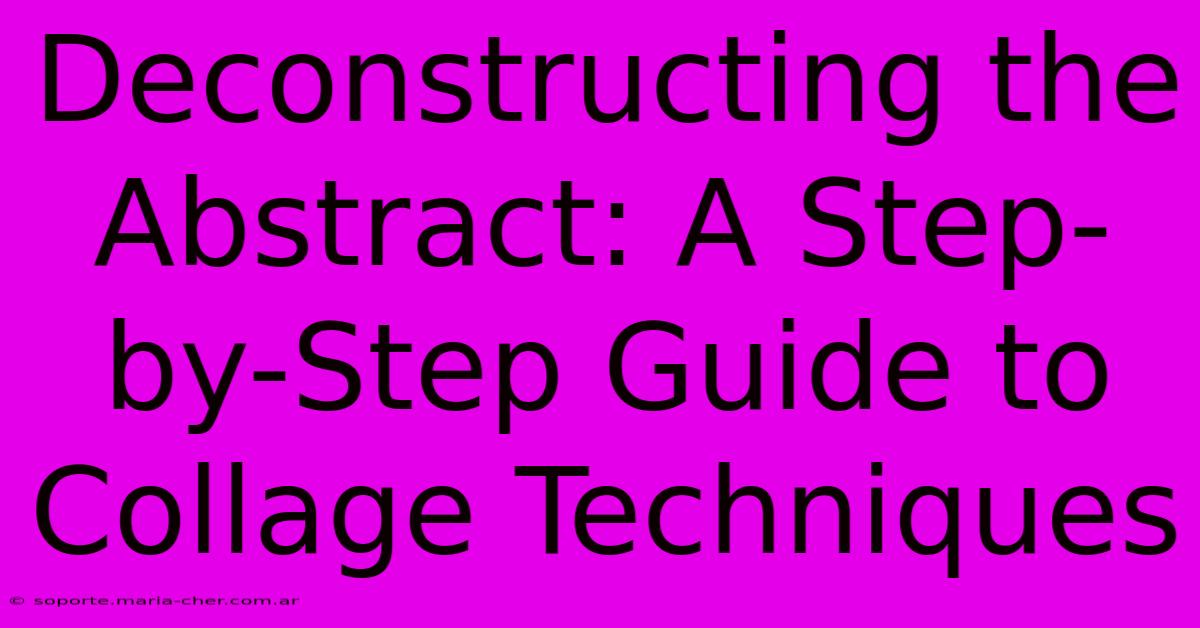Deconstructing The Abstract: A Step-by-Step Guide To Collage Techniques

Table of Contents
Deconstructing the Abstract: A Step-by-Step Guide to Collage Techniques
Collage. The word itself evokes a sense of playful chaos, a vibrant collision of textures and images. But beneath the seemingly random arrangement lies a powerful artistic process, a method of deconstructing and reconstructing reality through the strategic placement of fragmented forms. This guide will take you through a step-by-step journey into the world of collage, empowering you to unlock your creative potential and express yourself through this dynamic medium.
Gathering Your Materials: The Foundation of Your Collage
Before diving into the creative process, it's essential to gather your materials. The beauty of collage lies in its versatility; you can use practically anything! However, a well-stocked arsenal will significantly enhance your artistic journey. Here's a suggested list:
- Paper: This is the backbone of your collage. Experiment with various types: newsprint, magazine clippings, photographs, tissue paper, colored paper, construction paper, even book pages! The diversity of textures and tones will add depth and interest.
- Scissors & Utility Knife: Sharp scissors are crucial for precise cuts, while a utility knife offers more control for intricate details and tearing effects.
- Adhesive: Choose an adhesive appropriate for your materials. Glue sticks are great for paper, while archival-quality adhesives are preferred for more permanent projects. Consider using double-sided tape for ease of placement and repositioning.
- Surface: A sturdy surface to work on is a must. A cutting mat protects your workspace and prevents damage to your table.
- Optional Extras: Consider adding embellishments like paint, ink, markers, stamps, ribbons, fabric scraps, or even found objects. These elements introduce unexpected textures and dimensions to your work.
Step-by-Step Collage Creation: From Concept to Completion
Now for the fun part! Let's break down the collage process into manageable steps:
1. Conceptualization: Finding Your Focus
Before you start snipping and gluing, take time to brainstorm your concept. What message or emotion do you want to convey? What visual themes resonate with you? Even abstract collages benefit from a foundational idea, however loose it may be. Mood boards can be incredibly helpful in this stage.
2. Gathering and Selecting Your Elements: The Building Blocks
Now, gather your chosen materials. Start sorting through your paper and other materials, selecting pieces that visually align with your concept. Don't be afraid to experiment and mix unexpected elements. This is where the magic happens!
3. Cutting and Shaping: Precision and Intuition
Carefully cut or tear your chosen elements. Experiment with different shapes and sizes. Consider the negative space around your shapes—it's just as important as the shapes themselves. Precise cuts create a sense of order, while torn edges inject a more raw, spontaneous feel.
4. Arrangement and Composition: Balancing the Elements
This is where the artistry truly shines. Arrange your cut pieces on your working surface before applying adhesive. Play with different layouts, considering balance, contrast, and visual flow. Don't be afraid to rearrange and experiment until you find the perfect composition. Consider the Rule of Thirds or other compositional guidelines to guide your arrangement.
5. Adhesion and Refinement: Bringing it All Together
Once you’re satisfied with your arrangement, carefully apply adhesive to the back of each element and place it onto your chosen surface. Work methodically, ensuring proper adhesion. Once the adhesive is dry, you may choose to add further refinements, like paint, ink, or other embellishments.
6. Finishing Touches: The Final Polish
Once your collage is complete and the adhesive is dry, consider framing your work to protect it and enhance its presentation. A well-chosen frame can elevate your collage and complement its overall aesthetic.
Expanding Your Collage Horizons: Exploring Different Styles
The possibilities are endless! Explore various styles to discover your unique voice:
- Geometric Collage: Focus on precise shapes and patterns, creating a sense of order and structure.
- Organic Collage: Embrace irregular shapes and textures, evoking natural forms and flows.
- Photo Collage: Utilize photographs, creating narratives or exploring themes through imagery.
- Mixed Media Collage: Incorporate various materials beyond paper, like fabric, metal, or found objects, adding depth and complexity.
Beyond the Canvas: Collage in the Real World
Collage isn't confined to the studio. Explore its applications in other areas:
- Journaling: Create visually engaging journal entries.
- Greeting Cards: Design unique and personalized greeting cards.
- Fashion: Incorporate collage elements into clothing design.
Embrace the journey, experiment fearlessly, and discover the boundless creative possibilities within the art of collage. Your unique artistic voice awaits!

Thank you for visiting our website wich cover about Deconstructing The Abstract: A Step-by-Step Guide To Collage Techniques. We hope the information provided has been useful to you. Feel free to contact us if you have any questions or need further assistance. See you next time and dont miss to bookmark.
Featured Posts
-
Apple Licious Newsletter Ideas 9 Ways To Spice Up Your September Content And Harvest Subscriber Delight
Feb 08, 2025
-
Onyxs Dark Desires Unlocking The Secrets Of Black Roses
Feb 08, 2025
-
Flower Power Wholesale The Ultimate Babys Breath Bonanza
Feb 08, 2025
-
Blush Blooms The Endearing Charm Of Peach And Pink Roses
Feb 08, 2025
-
Your Office Your Way Discover The Advantages Of Hourly Office Rental In Nyc The Ultimate Workspace Solution
Feb 08, 2025
